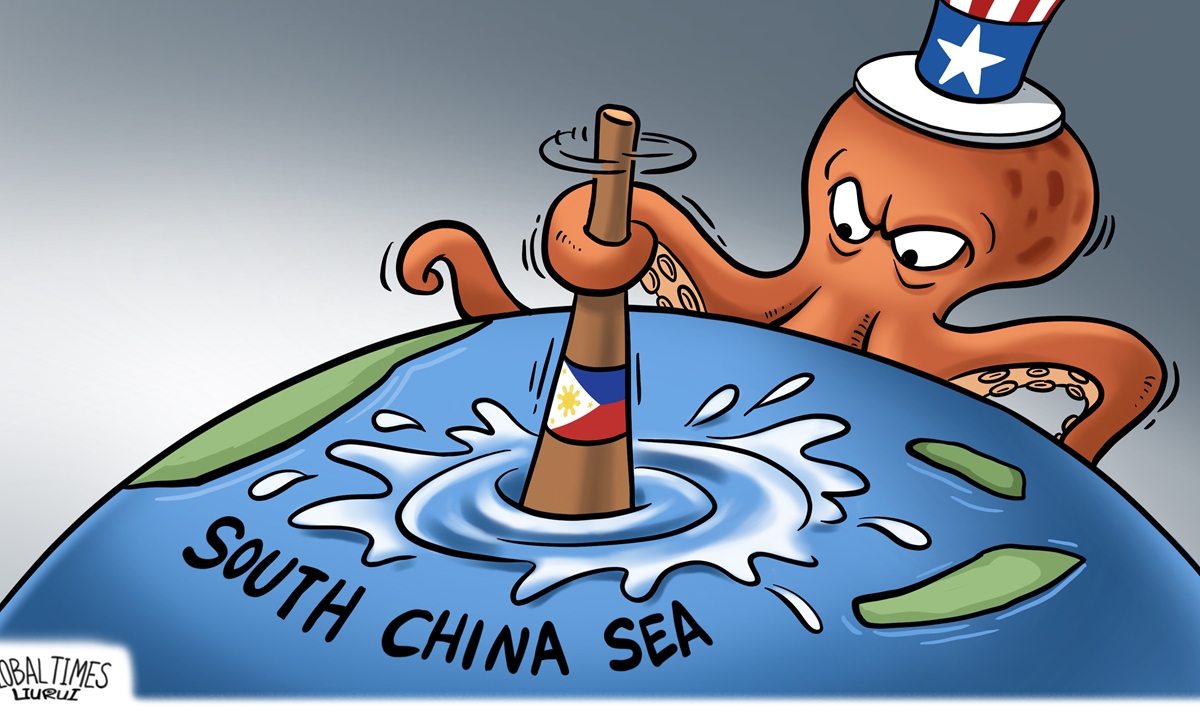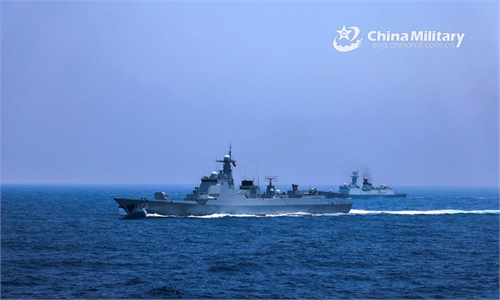Manila should be aware of the perils of acting as a US stick to muddy South China Sea

Illustration: Liu Rui/GT
The Philippines is regarded as a key component in the US Indo-Pacific Strategy. But compared to Tokyo and Canberra, which take on more aggressive roles, Manila, in the heart of Washington, is merely a stick used to muddy the waters of the South China Sea. In other words, the US aims to use the Philippines to continue escalating the China-Philippines dispute in the South China Sea and disrupt the friendly atmosphere of consultation between China and Southeast Asian countries on the South China Sea issue.The Philippines on Friday condemned China, stating that a Chinese coast guard ship on Wednesday came within a meter of colliding with a Philippine patrol ship near Ren'ai Reef. It accused China of conducting "the closest dangerous maneuver."
Beijing and Manila have already had several rounds of clashes in the South China Sea in recent months. This time, the Philippines' actions have once again confirmed a concerning trend: It has joined forces with the US to stir up new troubles in the South China Sea, becoming a destabilizing force in the Asia-Pacific region.
Under the general context of the Joe Biden administration's push for military and political cooperation with the Philippines based on the US Indo-Pacific Strategy, Philippine President Ferdinand Romualdez Marcos Jr abandoned his predecessor's rather friendly policy toward China after he came to power. Instead, he focused more on using the enchantment of ties with the US to promote the development of his country's military capabilities, hoping to consolidate domestic support. In addition, by constantly provoking troubles with China in the South China Sea, Manila wants to test how strong the US-Philippines alliance is.
As tensions between China and the Philippines in the South China Sea grow, Washington and Manila kicked off Maritime Training Activity Sama Sama 2023 off the Philippine coast on Monday. The main character in these military drills that will run through October 13, in fact, is still the US, which is purely exploiting the Philippines' close geographic location to China and its South China Sea disputes with China. Under the pretext of "addressing a spectrum of security threats and enhancing interoperability," Washington is targeting China through the Sama Sama drills.
Seeking to form more closed, confrontational minilateral mechanisms in the region similar to the Quad and AUKUS, Washington is glad to see Manila play a certain role in the vision of its Indo-Pacific Strategy. However, once the Philippines decides to tie itself up to the US' chariot, it will certainly go against the idea of ASEAN as a whole - These countries don't want the region to become a battleground for great power competitions, nor do they want to become proxies for great powers.
During the Rodrigo Duterte administration, the pragmatic and win-win cooperation between China and the Philippines has contributed much to the development of China, and the Philippines especially. If the Marcos Jr administration continues to drift off course in the South China Sea, turning the region into a sea of instability and driving China-Philippines relations into the vortex of conflicts, a disaster for the Philippines is inevitable, which will bring new uncertainties to bilateral ties and regional stability.
Chinese military expert Song Zhongping told the Global Times that if the Philippines, at the instigation of the US, turns into a bridgehead against China, it could become a battleground if the conflict escalates and this will plunge the country into the abyss of irretrievable losses. Therefore, the Marcos Jr administration needs to realize that the Philippines is only a pawn of the US and that Washington cannot be trusted.
It is not China that has pushed the Philippines toward the US, but the US that has forced ASEAN countries, particularly those that have disputes with China, to pick a side. China has never and will never pressure any ASEAN country, including the Philippines, to make a choice between siding with China or the US. As a peace-loving country, it always pursues to set aside the disputes in the South China Sea. At the same time, the direct communications channel between China and the Philippines over the South China Sea issue is still open, while Beijing has shown willingness to proactively engage in dialogues with Manila.
China and ASEAN countries should carry on with consultations on the Code of Conduct in the South China Sea, to strengthen bilateral cooperation and turn the South China Sea into a sea of peace, stability and win-win cooperation, instead of becoming a region of conflict and trouble under the constant involvement of extraterritorial countries.

